PAINTED FURNITURE: Learning about original surfaces
The set of dining room chairs in my parents house were sturdy survivors. They had to be with four kids who couldn’t just sit. I in particular used to rock back on two legs. But what didn’t survive was their original painted surface. They were Windsor (i.e. plank seats) chairs probably c. 1830. And they were stripped down to the bare wood and refinished. This is not at all surprising in that they were purchased in the 1950s, when many, many dealers and collectors didn’t appreciate, maybe even scorned painted surfaces on furniture. Fortunately for furniture which lucked out and kept their paint during the decades my parents collected, original painted surfaces on furniture are now much prized.

So a generation later I start collecting antiques hoping to avoid the sins of my elders. My principle advantage that they didn’t enjoy (nor were interested in) was reference books that started being published in the 1970s as well as museum installations in my home town Baltimore. And the painted furniture that was made in Baltimore, a city that blossomed in the early 19th century when elaborately painted furnishings was all the rage, was some of the finest produced in the fledgling United States. Not surprisingly, a set of six Baltimore chairs represented my first foray into collecting painted furniture. I had no misconceptions about my ability to afford chairs with untouched, little worn paint. So I bought a set of 6 “wheelback” chairs (mimicking Roman folding camp chairs) that had obviously been overpainted (although the design was right). At least the stamped brass bosses in the center of the wheel were present (behind the tassel cords).
It looks kind of nice–a sword in a scabbard with a helmet in front–but the workmanship is crude, the brushstrokes uneven, the pattern irregular. And on chairs this stylish the yellow probably was gold leaf not paint as it is now.

For the kitchen we chose country Windsor chairs, sturdy like my parents’ set and about a generation later, but of course with good paint. These were probably made in Lancaster Co., PA, 1840-60. Thousands of similar chairs were made in Southeastern Pennsylvania for decades. Like ours, many were painted freehand. The hands that painted these flowers and striped the lines were well practiced.
One must always remember when looking at (particularly early) 19th-century furniture that the artisans who made them were very conscious of the time involved needed to do their chores. Journeymen, who went through five to seven years training as apprentices, made about a dollar a day in urban shops. Furniture, particularly a custom-ordered piece, was priced by the wood used and the labor (i.e. the time) required. A basic table cost so much; carved legs added so much; a stenciled border added yet more, etc, etc.
A painter (ornamenter) was expected to complete so much work in a day. And he may have been a specialist who only did painting, again and again and again. His work would show proficiency, clean execution, and lack of fussiness.
This Windsor settee has a top rail shaped like three kitchen chairs glued together. It may be a generation early than the chairs and made in a Philadelphia or nearby South Jersey shop. Stenciling may have been used and gold leaf. The painter made an effort to paint shadows under the fruit, leaves, and “angel wings” on the curved rail ends. Once again the paint was applied in quick, deaf strokes. No fuss, no bother.

The same shaped top rail was used on a Pennsylvania rocking chair. Here the decorator relied almost solely on stencils. Atop the brown base paint, a single stencil was fitted across the width of the top rail. So all the birds, fruit, leaves and surrounding ornaments were applied in one step. Next came colored powders that loosely conformed to the first stencil. This process was quick and colorful. Chances are that this practice of a single overall stencil does not represent the first generation of stencil use. For instance….
This is the middle rail from a group of four New England or New York state side chairs. Note that except for the central tulip, all the decoration is composed of repeated elements. Each grape leaf was made by brushing gold or bronze powders through the same stencil. Same for the melons of two different sizes. Ditto the stalks of wheat. Even the veins of the leaves had their own stencil. I guess the pattern was made from the left and right sides towards the center, with the tulip placed last. By feathering the powders (applying less and less away from the edges of the stencil) allowed the next stenciled element to appear to overlap the previous one. This helped to create a three-dimensional effect. Compare this to the rocking chair above.
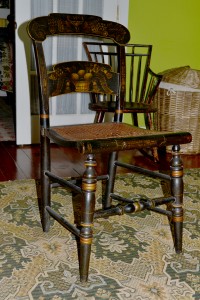

This is the middle rail of a chair (right) labeled by the “Hitchcock, Alford & Co., Hitchcocksville, Conn. Warranted.” (The firm operated from 1832 to 1843.) Except for the stencil for the basket, each stencil again is used more than once. There was even a separate stencil for the centers of the grapes.
And below is the middle rail of a pair of chairs (left) that could be from Ohio. This also to created by the use of multiple stencils. Note how the wing feathers are built up layer upon layer. I suspect the black line work on the cornucopias is freehand.
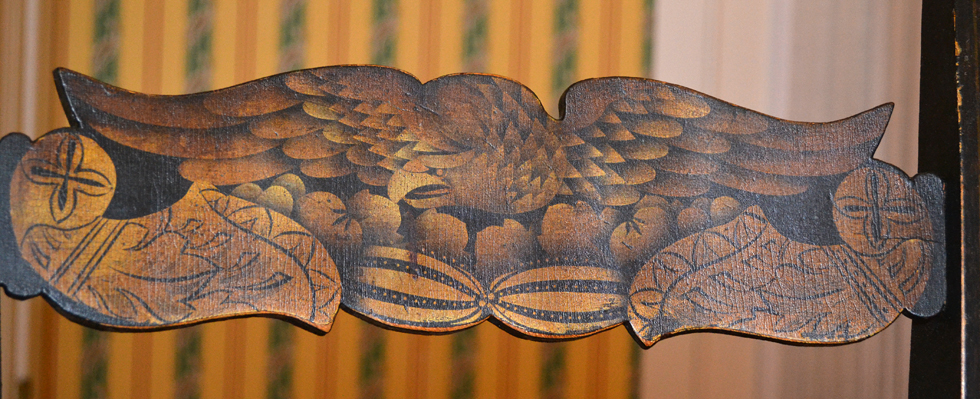
In all the cases above the emphasis was on the freehand and stenciled decoration. The background was a solid color as in the three Pennsylvania examples above or darkly faux painted to mimic rosewood as on the last three examples (not visible in the brightly decorated parts photographed). In some cases the faux bois work was so convincing that it shared top billing with the stencil work.
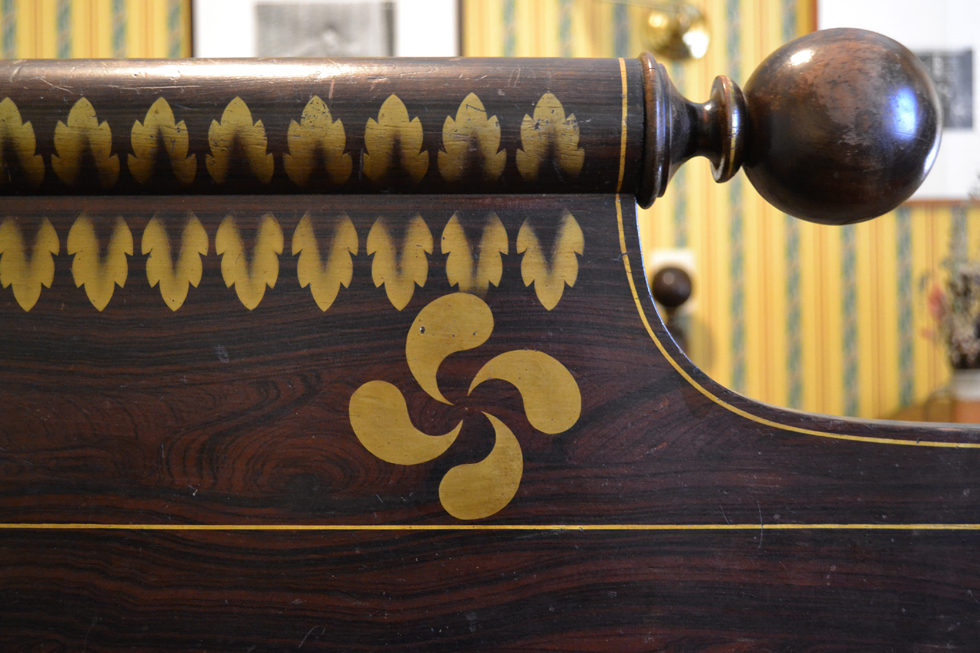

The enlargement is from a corner of the foot board of a bed, c. 1830, made by the John Hancock & Company in Philadelphia. The firm patented the mechanism (swelled beam windlass) used to tighten the mattress. The overall picture is of our bed published in American Painted Furniture by Cynthia Schaffner and Susan Klein, 1997. (P.S. the publishers inadvertently flipped the photo left and right. P.P.S. The guest bedroom is too tight for my camera to render a decent overall shot. Ergo, the bit of showing off.) Here the rosewood graining really fools the eye. While the stencil work is quite simple, yet effective.
And sometimes the wood graining is a tour de force….
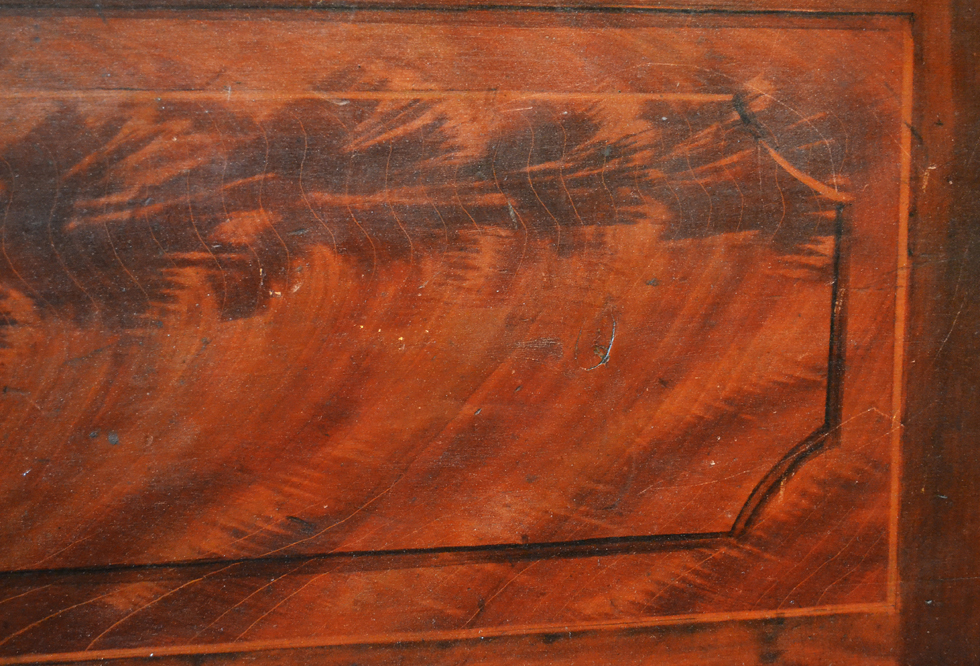

This is a blanket chest from upstate New York. Blanket chests inspired a great number of decorative painters. Their broad flat surfaces were excellent canvases. Pennsylvania Germans in particular loved highly decorated chests, peopled with gardens and horses and unicorns, even people. On other chests painters playfully applied graining that only vaguely looked like wood. It was paint for paint’s sake. My pocketbook forbid me from chasing down these fanciful types of painted chests. But a blanket chest like the one shown here doesn’t appear on many collectors’ radar screen. But I think it’s terrific. Not only did its painter do a great job of faking crotch mahogany veneering, but he faked a raised panel construction with cutout (ovolo) corners. Note the shadowing to the right and below the faked raised panels, as if the light source was from the upper left.
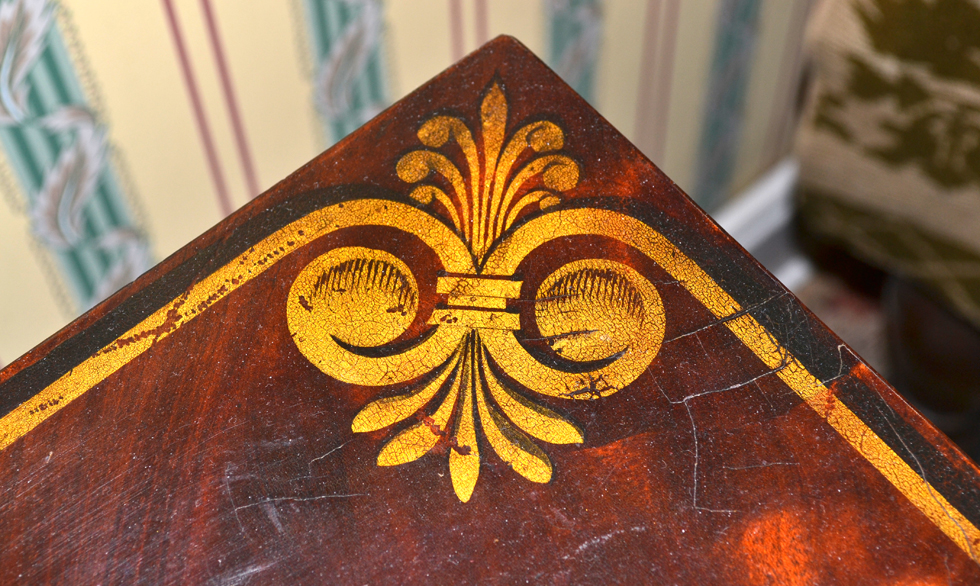
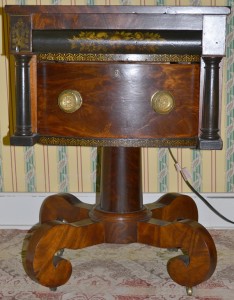

And sometimes in fancy urban shops decoration was applied directly on the wood. Here gold lead enhanced with a few penned or painted lines created an elegant corner to a New York worktable top. On parts of the front several areas were ebonized (blackened) then stenciled.


And sometimes wood was not the support used for the painted decoration. Glass was, on the reverse side from the viewing side. This happened mostly on mirrors and clocks. Baltimore had a brief period (around 1800) during which painted glass panels were embedded in furniture. The clock is of a type called a triple decker, i.e. a stack of three glasses. Like most clocks it’s labeled. Birge, Peck & Co. operated in Bristol, Conn., from 1830-56. The non-figuarative painting style is often associated with William Fenn, a noted mid-19th-century tablet painter. He used stencils with freehand. Of course the wood dial was painted too. That was another person’s specialty. And the half columns feature faux tortoise shell painting as well as gold leaf. It’s sort of a glossary of ornament types.
I think I’ll close with two sets of Philadelphia fancy chairs. Both from about 1830 feature a Greek form of klismos legs, which when viewed from the side curve away from each other.
The left two are from a set of six purchased some 12 years ago. Their paint decoration combines faux graining (tiger maple) and hand painting, some of which has been retouched. In the first enlargement, note that the top rail’s gold design is uneven, a bit scrubby, while the middle rail’s gold paint is smooth and even. The design is right out of the style books of the day, but the execution is rather amateurish.
The right two are a pair of chairs just purchased very inexpensively. Who knows why. They’re in remarkable shape and very sophisticated. The gold leaf and delicately overpainted design is nearly intact. (See the lower enlargement) The lower rail has a central roundel in gold leaf that’s painted like a recessed flower, while the supporting leaves (or partially opened lotus blossoms) mimic shallow carving found on mahogany chairs made in Philadelphia at the same time.

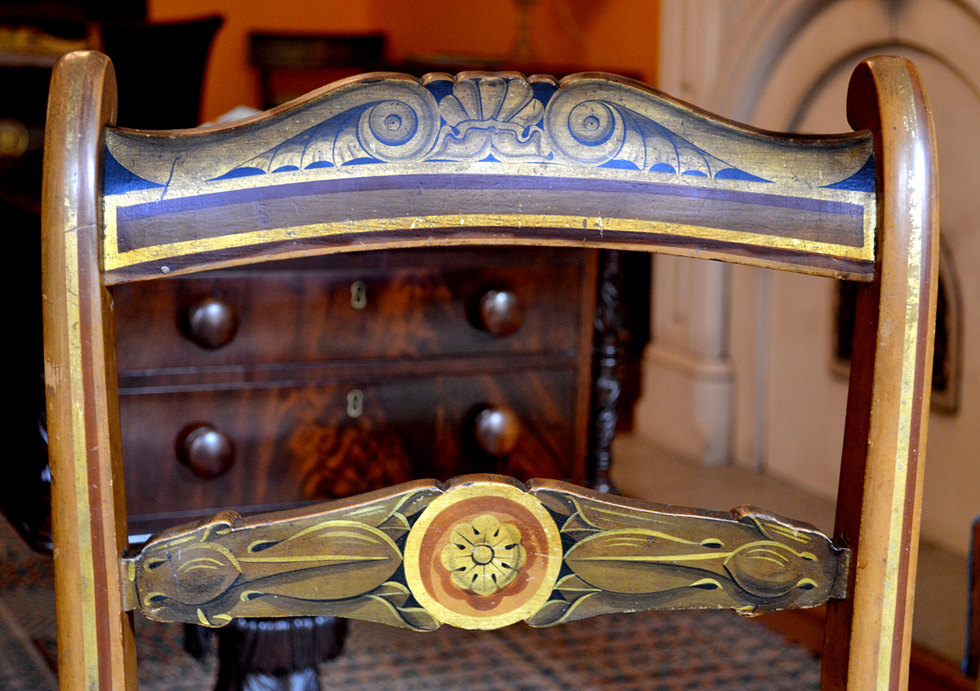
All and all, I’ve had quite an education in painted furniture surfaces. I doubt that I would buy those six Baltimore “wheelback” chairs now. Yet I don’t regret that I did. Without them I may never have gone on the journey that I did.
Trackback URL: https://www.scottponemone.com/painted-furniture-learning-about-original-surfaces/trackback/





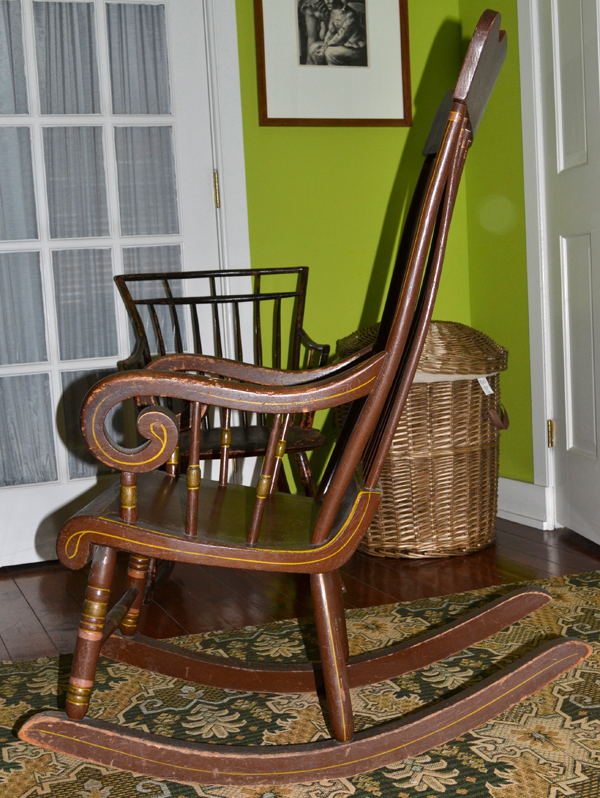

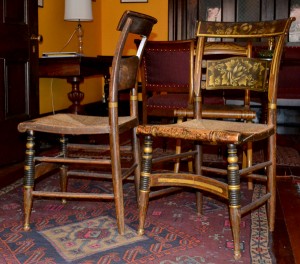












Hi Scottie,
Thanks for the lesson on painted furniture. I think if I had stayed in Baltimore I would own a few painted pieces of furniture too. At least a set of dining room chairs. I enjoyed your article.
Hi Scottie,
You have an amazing collection. I admire you for having the forethought you had to collect painted furniture.
Thank you for sharing your knowledge. I’ve been tryi ng to find info on a hitchcock rocker i have with an eagle stencil.
I’ll be writing a post today on a high-back painted chair. It’s not stenciled like Hitchcock seating furniture, but I think you’ll find it interesting.
Lisa, the new post is http://www.scottponemone.com/2016-marble-pier-table-high-back-fancy-chair/
Thank you for sharing